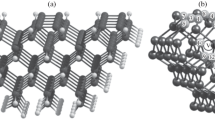Abstract
In the present investigation, we have employed the adsorption of H-H at the bcc site of V (100) with use of an ab initio method. The most stable adsorption configuration has been found on transition metal surface with chemisorption energies. Although similar in type and energy, the adsorption on the V (100) surface shows a markedly different optimized geometry. The calculations have performed for small clusters representing three adjacent metal sites. Upon the adsorption, the molecule forms strong covalent bonds with the surface, whereupon the structure of nearby single H-H and H-V bonds change at various positions of top, bridge, and center sites in this model. We have predicted the existence of a new ordered structure comparable in stability to one proposed previously. We confirm the preference of the top approach of adsorption configuration suggested by experiment. Adsorption of H2 from the top site goes through the same from the bridge and center sites, but the former has a higher energy.
Similar content being viewed by others
References
G. C. Wang and Y. H. Zhou, J. Chem. Phys. 122, 044707 (2005).
D. E. Jiang and E. A. Carter, Surf. Sci. 547, 85, (2003).
G. A. Somorjai, Introduction to Surface Chemistry and Catalysis (Wiley, New York, 1994).
R. B. Anderson, The Fischer-Tropsch Synthesis (Academic Press, Orlando, Fla, 1984).
W. Zhong, Y. Cai, and D. Tomanek, Nature 362, 435 (1993).
J.-S. Wang, Eng. Fract. Mech. 68, 647 (2001).
A. I. Livshits, F. Sube, M. N. Solovyev, et al., J. Appl. Phys. 84, 2558 (1998).
K. Hermann, A. Chakrabarti, and R. Druzinic, M. Witko, Physica Status Solidi (a) 173, 195 (1999).
R. Koller, W. Bergermayer, G. Kresse, et al., Surf. Sci. 11, 480 (2001).
M. A. J. Quinn, J. Schmid, R. Redinger, et al., Phys. Rev. Lett. 86, 2396 (2001).
D. L. Smith, M. C. Billone, and K. Natesan, Int. J. Refract. Met. Hard Mater. 18, 213 (2000).
A. I. Livshits, M. E. Notkin, and A. A. Samartsev, J. Nucl. Mater. 170, 79 (1990).
R. A. van Santen and M. Neurock, Catal. Rev. Sci. Eng. 37, 557 (1995).
Author information
Authors and Affiliations
Corresponding author
Additional information
Original Russian Text © M. Monajjemi, M.T. Baei, F. Mollaamin, 2008, published in Zhurnal Neorganicheskoi Khimii, 2008, Vol. 53, No. 9, pp. 1529–1536.
Rights and permissions
About this article
Cite this article
Monajjemi, M., Baei, M.T. & Mollaamin, F. Quantum mechanic study of hydrogen chemisorptions on nanocluster vanadium surface. Russ. J. Inorg. Chem. 53, 1430–1437 (2008). https://doi.org/10.1134/S0036023608090143
Received:
Published:
Issue Date:
DOI: https://doi.org/10.1134/S0036023608090143




